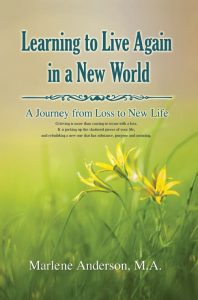Listen to this episode of the Focus with Marlene Podcast
Click here to get caught up on all episodes in this series on recovering from loss
All successful people have a goal. No one can get anywhere unless he knows where he wants to go and what he wants to be or do.
—Norman Vincent Peale
Last week we addressed conflicts and problems that exist between more than one person, and how you can properly identify the problem, given two different perspectives.
This week I share a major problem I faced and how I was able to resolve it.
After the death of my husband, I was faced with a huge financial decline along with a house we had just built, a small mortgage and lack of immediate resources.
My basic problem: What do I do now? What are my options?
Additional problems: If I have to move, where will I move to? How much can I spend on a different home?
Here are some of the ways I explored my basic problem and solutions I tried.
Through this process I was able to set my final criteria for where I wanted to live with a move I needed to make.
- I could stay in my house and rent my daylight basement. I tried that but found I was uncomfortable with that as a solution.
- I could become even more frugal and try to make it without selling. While I can be very frugal and had a small income each month, I realized there would be increases to homeowner costs, tax increases, etc. that I needed to prepare for.
- If I sold my house, would the sale of my home furnish me with enough money to purchase another? This created additional questions, such as: Where would I move? Do I rent or buy? Do I stay within the community or move closer to my kids? What were the pros and cons of each?
- Should I consider going back to work even though I was retired? I did not want to return to full-time teaching. Would part-time work give me enough funds to remain in my current house and still meet increased costs and unexpected emergencies?
The possibility of having to sell the beautiful home my husband and I had just built was not something I wanted to entertain. But as I examined each of the questions and potential solutions, carefully evaluating each, I realized my options were limited.
I had to assess what I wanted for my future long-term as well as any financial restraints involved. I was not just evaluating whether I could remain in my current home, but where I could move to, whether to rent or purchase. This was a major life-changing decision. After carefully thinking through all potential options, I made my decision to sell my home and purchase another.
Then I had to decide where I wanted to move to.
Should I move closer to my kids, return to the state where we had lived before, or remain in this area? After exploring homes on the market in surrounding towns, I made my final decision. I wanted to remain in my same community.
Next, I needed to determine what I could afford.
When I looked at the homes available to me within the price range I had set, however, they required some kind of upgrade or remodeling which would then increase the total price of the home.
As I brainstormed other options, it occurred to me that I could purchase one of the available lots and move a modular home on it as there were many wonderful models available to choose from in my price range.
But when I considered the cost of the lot, building a foundation, and a move from the factory, I realized I could build a house from the ground up for the same price and I would have more square footage and design options.
Problem-solving will take you through many opportunities to increase your list of choices.
Brainstorming and evaluating as many of those options as possible is also an opportunity to refine your criteria, your wants and needs.
As I expanded my awareness of what I could work with and do, it enabled me to see many possibilities I would never have considered when I started. By exhausting all possibilities and then choosing the best, I was able to arrive at a final decision that went far beyond my dreams. I was able to build a house I could never have afforded otherwise.
As you work with your ideas, you can evaluate and discover more of what you want.
When you have enough information and evaluate the pros and cons of each, you will be able to choose one that best fits your needs and implement a plan of action. Through this process, you are allowing new ideas to surface that you might not have thought of otherwise. I ended up with a home and an asset I would not have had otherwise.
When you start problem-solving and brainstorming ideas, don’t limit yourself.
As new possibilities pop up, consider them valid considerations. In the process you will clarify your criteria.
Be open to new ideas when they present themselves.
Be willing to look at many different possibilities before making a final decision. When you have exhausted all your options, you will find one that is right for you.
I love my new home and never would have had it if I hadn’t gone through the process I did. Have faith in yourself. Talk to others, gather that information, and then go for it.
 Learning to Live Again in a New World
Learning to Live Again in a New World
We need validation for the turmoil of thoughts and emotions we experience. But we also need the tools necessary to create a new beginning that is both satisfying and meaningful. My new book, Learning to Live Again in a New World, offers those tools to help work through the problems you might be facing.
It is a guide to help you through the ups and downs of grieving a significant loss. And it includes a study guide at the end for use with groups.
Marlene Anderson


